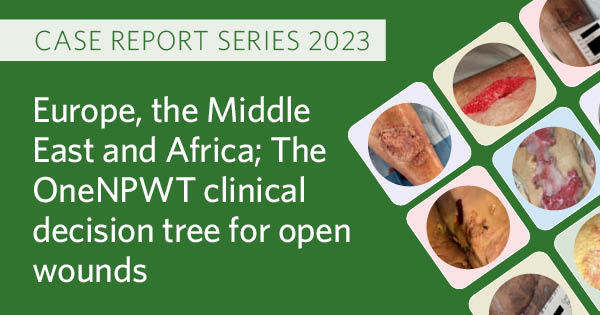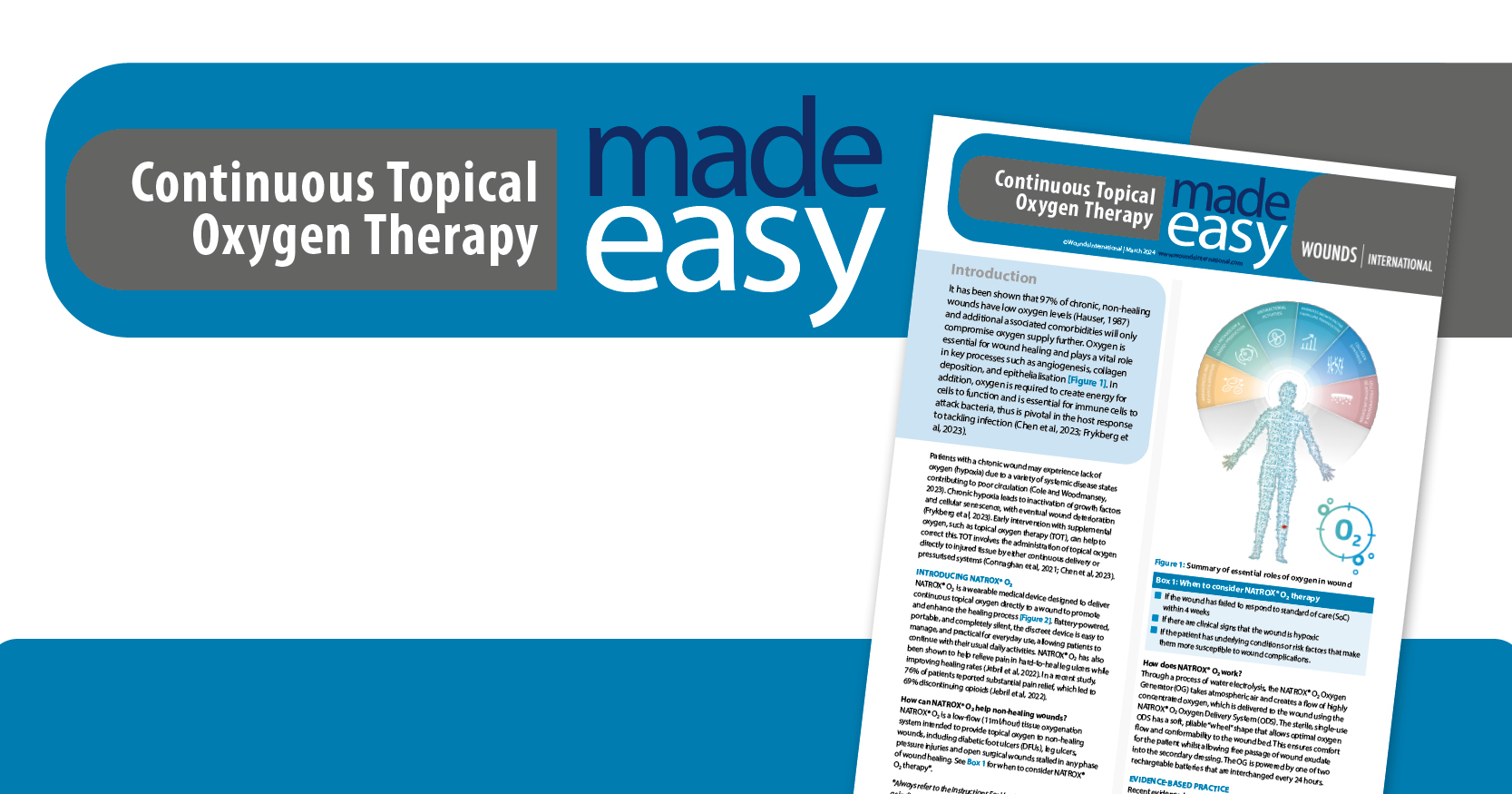ReferencesApelqvist J, Willy C, Fagerdahl AM et al (2017) EWMA Document: Negative Pressure Wound Therapy. J Wound Care 26: S1-S154
Banasiewicz T, Banky B, Karsenti A et al (2019) Traditional and single-use NPWT: when to use and how to decide on the appropriate use? Recommendations of an expert panel. Wounds International
Brownhill R (2019) PICO◊ Biomechanical Study. Data on file report. DS/19/211/R
Cray A (2017) Negative pressure wound therapy and nurse education. Br J Nurs 26(15): S6-S18
Dowsett C (2017) Breaking the cycle of hard-to-heal wounds: balancing cost and case. Wounds International
Dowsett C, Hampton K, Myers D, Styche T (2017) Use of PICO to improve clinical and economic outcomes in hard-to-heal wounds. Wounds International 8(2): 52-8
Fraccalvieri M, Fierro MT, Salomone M et al (2012) Gauze-based negative pressure wound therapy: a valid method to manage pyoderma gangrenosum. International Wound Journal 11: 164-68
Guest JF, Fuller GW, Vowden P (2020) Cohort study evaluating the burden of wounds to the UK’s National Health Service in 2017/2018: update from 2012/2013. BMJ Open 10(12): e045253
Gupta S, Sagar S, Maheshwari G et al (2021) Chronic wounds: magnitude, socioeconomic burden and consequences. Wounds Asia
Hampton J (2015) Providing cost-effective treatment of hard-to-heal wounds in the community through use of NPWT. Community Wound Care S14-S20
Hudson DA, Adams KG, Van Huyssteen A et al (2015) Simplified negative pressure wound therapy: clinical evaluation of an ultraportable, no-canister system. Int Wound J 12(2): 195–201
Hurd T (2013) Evaluating Cost and Benefits of Innovations in Chronic Wound Care Products and Practices. Ostomy Wound Manage S1-S13.
Hurd T, Gilchrist B (2020) Single use negative pressure wound therapy (sNPWT) in the community management of chronic open wounds deeper than 2cm. Paper presented at: Symposium on Advanced Wound Care/Wound Healing Society Meeting; 2020; Abu Dhabi
Hurd T, Kirsner RS, Sancho-Insenser JJ et al (2021) International Consensus Panel Recommendations for the Optimization of Traditional and Single-Use Negative Pressure Wound Therapy in the Treatment of Acute and Chronic Wounds. Wounds 33(2): S1-S11
Janssen AHJ, Wegdam JA, de Vries Reilingh TS et al (2021) Which determinants are considered to be important for adherence to Negative Pressure Wound Therapy: A multimethods study. J Tissue Viability 30(2): 250-255
Jeffery SL (2014) The use of an antimicrobial primary wound contact layer as liner and filler with NPWT. J Wound Care 23(8): S3-14
Kirsner R, Dove C, Reyzelman A, Vayser D, Jaimes H (2019) A Prospective, Randomised, Controlled Clinical Trial on the Efficacy of a single-use Negative Pressure Wound Therapy System, compared to Traditional Negative Pressure Wound Therapy in the Treatment of Chronic Ulcers of the Lower Extremities. Wound Repair Regen 27(5): 519–529
Kirsner RS, Delhougne G, Searle RJ (2020) A cost-effectiveness analysis comparing single-use and traditional negative pressure wound therapy to treat chronic venous and diabetic foot ulcers. Wound Manag Prev 66(3): 30–38
Kirsner RS, Hurd T (2020) Assessing the Need for Negative Pressure Wound Therapy Utilization Guidelines: An Overview of the Challenges With Providing Optimal Care. Wounds 32(12): 328-33
Lalezari S, Lee CJ, Borovikova AA et al (2017) Deconstructing negative pressure wound therapy. Int Wound J 14(4): 649-57
Malmsjö M, Ingemansson R, Martin R, Huddleston E (2009) Negative pressure wound therapy using gauze or open‐cell polyurethane foam: similar early effects on pressure transduction and tissue contraction in an experimental porcine wound model. Wound Repair Regen 17: 200–5
Nherera LM, Trueman P, Karlakki SL (2017) Cost-effectiveness analysis of single-use negative pressure wound therapy dressings (sNPWT) to reduce surgical site complications (SSC) in routine primary hip and knee replacements. Wound Repair Regen 25(3): 474-82
Patel A, Delhougne G, Nherera L (2019) Comparison of wound closure in chronic lower extremity ulcers between single use negative pressure wound therapy and traditional negative pressure wound therapy: a real world analysis. Paper presented at: National Wound Conference; 2019; Las Vegas, NV, USA
Seidel D, Diedrich S, Herrle F et al (2020) Negative Pressure Wound Therapy vs Conventional Wound Treatment in Subcutaneous Abdominal Wound Healing Impairment: The SAWHI Randomized Clinical Trial. JAMA Surg 155(6): 469-78
Sen CK (2019) Human Wounds and Its Burden: An Updated Compendium of Estimates. Adv Wound Care (New Rochelle) 8(2): 39-48
Sen CK, Gordillo GM, Roy S et al (2009) Human skin wounds: a major and snowballing threat to public health and the economy. Wound Repair Regen 17(6): 763-71
Smith+Nephew (2018) Summary of routine QA testing on MVP of PICO dressings. Internal Report. DS/18/153/R
Smith+Nephew (2019) Use of Moisture Vapour Permeability* (MVP) and Moisture Vapour Transmission rate** (MVTR) data to support product claims referring to moist wound healing. Internal Report
Smith+Nephew (2020) Bacterial barrier testing of the PICO Dressing. Internal Report. 2001002
Tanaydin V, Beugels J, Andriessen A et al (2018) Randomized Controlled Study Comparing Disposable Negative-Pressure Wound Therapy with Standard Care in Bilateral Breast Reduction Mammoplasty Evaluating Surgical Site Complications and Scar Quality. Aesthetic Plast Surg 42(4): 927-35
Tuncel U, Erkorkmaz Ü, Turan A (2013) Clinical evaluation of gauze-based negative pressure wound therapy in challenging wounds. Int Wound J 10(2): 152-8
World Union of Wound Healing Societies (2019) Wound exudate: effective assessment and management. Wounds International
World Union of Wound Healing Societies (2020) Optimising wound care through patient engagement. Wounds International







